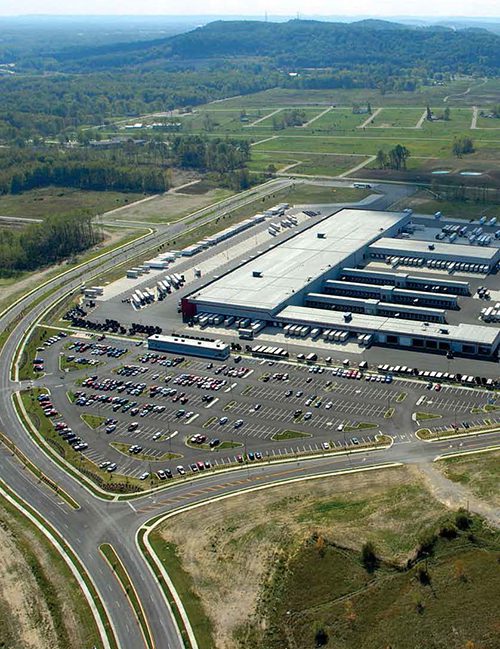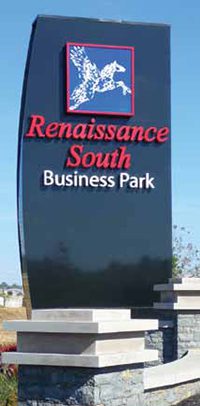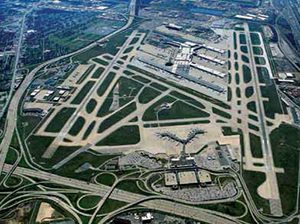 A pending $2.3 million land sale at Louisville International Airport (SDF) in Kentucky marks another step in converting 700 acres previously populated with residential properties into commercial developments that benefit the airport, greater Louisville economy and United Parcel Service (UPS), the region's biggest employer and airport's largest tenant. The properties are being voluntarily vacated through an airport noise relocation program.
A pending $2.3 million land sale at Louisville International Airport (SDF) in Kentucky marks another step in converting 700 acres previously populated with residential properties into commercial developments that benefit the airport, greater Louisville economy and United Parcel Service (UPS), the region's biggest employer and airport's largest tenant. The properties are being voluntarily vacated through an airport noise relocation program.
The Louisville Renaissance Zone Corporation (LRZC), an airport-affiliated agency that oversees development of the airport's Renaissance South Business Park, has agreed to sell 18.4 acres of airport land to Dermody Properties LLC, a private industrial property developer headquartered in Reno, NV. Funds from the expected sale will pay for infrastructure improvements in the business park, says Skip Miller, executive director of the Louisville Regional Airport Authority.
Dermody plans to build a 316,481-square-foot building on speculation. The new structure, which will be designed for warehousing, distribution, light-manufacturing and/or logistics-related use, should be ready for occupancy next spring, reports Brian Quigley, Midwest Region partner for the developer.
While a tenant has yet to be announced, one thing is certain: SDF's status as the global air hub for
|
factsfigures
Project: Commercial Landside Development Location: Louisville (KY) Int'l Airport Name of Development: Renaissance South Business Park New Site Size: 18.4 acres Proposed Structure: 300,000 sq. ft. Purpose: Light manufacturing, warehousing, distribution, logistics Private Developer: Dermody Properties Of Note: A separate but airport-affiliated entity that qualifies for Tax Increment Financing was formed to support commercial development of airport property |
UPS Airlines served as a strong catalyst for the development. From a sheer physical standpoint, UPS facilities occupy more than half of the airport grounds. The delivery giant's Worldport package handling center is as big as 80 football fields. From an operations standpoint, UPS accounts for more than half of SDF's takeoffs and landings, and provides the backbone of its ranking as the third-busiest cargo airport in North America and seventh-busiest in the world. Moreover, the company is the largest employer in Louisville, with roughly 20,000 full-time-equivalent workers.
In short, the airport, UPS and the city of Louisville have a symbiotic relationship, explains Miller. What benefits one generally benefits the others.
Case in point: the proposed Dermody development will stand across the street from the UPS Centennial Hub, the company's regional ground sorting operation and the business park's largest commercial development. Built on a 60-acre site, the facility features a 258,000-square-foot distribution center and 1.1 million square feet for parking and staging.
The strong UPS presence at the airport is what Dermody considers a "sustainable demand driver" – and also what makes SDF's business park the right place for one of the company's Class A industrial developments. "The location definitely motivates us to build this building," explains Quigley, noting that the airport development will be Dermody's second construction start in Louisville this year.
 Airport-Compatible Development
Airport-Compatible Development
The airport authority created LRZC in 2003 as a means of encouraging airport-compatible development on land at the south end of the airport. "When airports try to (develop property) under FAA rules and regulations, it becomes much more difficult. So we set up a separate organization that allows us to function more as a private developer than an airport operator," explains Miller.
Importantly, LRZC can receive revenue generated via a Tax Increment Financing (TIF) district, but the airport cannot. Members of the airport authority's board of directors also serve on LRZC's board.
Qualifying for TIF district participation provides a strategic funding mechanism for landside development at SDF. Approximately 80% of any increases in tax revenue generated by development within the roughly 3,000-acre TIF district that encompasses the airport business park can be used to pay for infrastructure improvements for the development. Property, employee withholding and state sales tax revenues are all considered in the formula. The airport authority, Louisville-Jefferson County government and the state authorized the TIF district under a cooperative agreement.
"We're not real-estate developers, so we didn't want to be in the business of marketing property," explains Miller. "Plus, airports do not have TIF authority, so we had to establish an agency with TIF authority. The TIF district provides seed money that allows us to fund incremental infrastructure development on a pay-as-you-go basis – things like roads, street lighting, sewers and stormwater detention."
In addition to leveraging the land's revenue potential, the airport authority wants to develop it in ways that support the airport and add to its role in the community, he adds.
Formerly a residential neighborhood, the land currently being developed was vacated through a voluntary relocation program associated with the airport's noise mitigation program. From 1996 through May 2013, more than 1,000 families elected to move from homes near the airport, making SDF's initiative one of the largest airport noise-relocation efforts in the United States, Miller notes. Most of the $165 million program was funded by FAA grants, but the airport paid for some expenses, he adds.
Nationwide Trend
According to Rick Crider, many U.S. airports use strategies similar to SDF's. Crider is general manager of Kelly Field at Port San Antonio, a redevelopment authority that has transformed the Texas airport into an aerospace/logistics/industrial platform. Crider also served as the principal investigator of "Guidebook for Developing and Leasing Airport Property," an Airport Cooperative Research Program publication.
"Airports are a magnet for commerce," says Crider. "A lot of airports are using TIF districts, development corporations and redevelopment authorities to turn fallow land and/or underutilized facilities into revenue-generating property. Such practices generally enhance economic development and job creation for the community, in addition to generating new revenue for the airport sponsor. That revenue can then be used to offset airport operating costs and relieve some of the pressure on rates and charges applicable to aviation users and activities."
Through 2009, the TIF district that includes SDF's business park has raised about $8 million in revenue. "So far, there's been very little TIF revenue generated," reports Miller, noting that the prolonged economic recession slowed the expected pace of development in Renaissance South. LRZC has invested more than $17 million in infrastructure improvements in the business park, including more than 20 building sites, ranging in size from two acres to 77 acres. Flexible zoning allows the sites to be used for retail, commercial and industrial purposes.
After Centennial Hub was built in 2008, major development within the park was quiet until last year, when Ford Motor Company leased 15 acres of land to build a 1,400-vehicle storage and staging lot to support its nearby assembly plant. Also in 2012, UPS Supply Chain Solutions, the company's warehousing arm, purchased 117 acres for $9.4 million for an expansion that could include up to six warehouses.
In late April, LRZC signed a letter of intent to sell almost 84 acres to Chicago-based Verus Partners LLC for $10.4 million. Verus eventually plans to build two 625,000-square-foot buildings, suitable for logistics and warehousing operations.
Room for Growth
In all, about one-third of the 700 acres of land remains undeveloped, reports Trish Burke, LRAA's director of public relations. In all likelihood, only about 150 acres of that is suitable for development because of its topography. Wetlands mitigation and infrastructure improvements such as a detention pond and roadways initially used up approximately 150 acres.
Both LRAA and LRZC benefit directly from the land development. LRAA, which sells land to the development corporation whenever it has purchased enough contiguous parcels through the noise-relocation program to make development feasible, invests the proceeds in other noise mitigation projects. LRZC uses the funds generated from land sales to developers to pay for infrastructure improvements.
"Initially, the business park looked like Swiss cheese – a lot of missing pieces," says Burke. "But as more people raised their hand and said they were ready for acquisition, we've been able to pull together parcels large enough for actual development."
UPS and the local metro government also benefit, because there's more land available for further logistics expansion. That's critical because the mere presence of UPS attracts businesses, notes Miller. Statistics from the greater Louisville area's chamber of commerce show that 155 companies have moved to the city since 1993 to locate near the company's ground- and air-delivery services.
The airport also plays an increasingly significant role in the area's economic development. In 2011, its economic impact included 64,000 jobs, $2.3 billion in payroll and total business expenditures of $7.1 billion, reports Miller.
"What's good for UPS is good for the community and the airport," he says.


